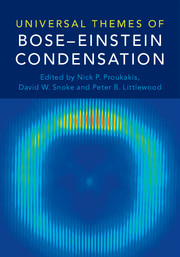Book contents
- Frontmatter
- Contents
- Foreword
- Preface
- Part I Introduction
- Part II General Topics
- Part III Condensates in Atomic Physics
- Part IV Condensates in Condensed Matter Physics
- Part V Condensates in Astrophysics and Cosmology
- Editorial Notes
- 29 Bose-Einstein Condensates in Neutron Stars
- 30 A Simulated Cosmological Metric: The Superfluid 3He Condensate
- 31 Cosmic Axion Bose-Einstein Condensation
- 32 Graviton BECs: A New Approach to Quantum Gravity
- Universal Bose-Einstein Condensation Workshop
- Contributors
- Index
- References
30 - A Simulated Cosmological Metric: The Superfluid 3He Condensate
from Part V - Condensates in Astrophysics and Cosmology
Published online by Cambridge University Press: 18 May 2017
- Frontmatter
- Contents
- Foreword
- Preface
- Part I Introduction
- Part II General Topics
- Part III Condensates in Atomic Physics
- Part IV Condensates in Condensed Matter Physics
- Part V Condensates in Astrophysics and Cosmology
- Editorial Notes
- 29 Bose-Einstein Condensates in Neutron Stars
- 30 A Simulated Cosmological Metric: The Superfluid 3He Condensate
- 31 Cosmic Axion Bose-Einstein Condensation
- 32 Graviton BECs: A New Approach to Quantum Gravity
- Universal Bose-Einstein Condensation Workshop
- Contributors
- Index
- References
Summary
Since superfluid 3He in the zero temperature limit is a pure condensate, all the constituent particles obey the same wavefunction, equivalent to a global set of field equations acting on all. Serendipitously, the symmetries broken to create the superfluid are also very similar to those broken by the metric of the universe soon after the Big Bang. The superfluid thus provides a powerful ‘tabletop’ medium for simulating cosmological processes. We explain here the analogies and describe our exploiting them in experiments to simulate cosmic string formation and brane annihilation in the early universe, yielding insight into what are otherwise experimentally inaccessible processes.
Introduction
The superfluid transition in liquid 3He can be regarded as a Bose-Einstein condensation of the fermionic Cooper pairs (or a variation thereof) resulting in a dense condensate, at the other end of the scale from the tenuous cold-gas equivalents. While the cold gases provide interesting laboratories for looking at problems of wider relevance, their limited size and densities can be a disadvantage. The superfluid 3He condensate, while less straightforward to achieve, has a number of beneficial properties which make it ideal for many experiments.
The analogies between superfluid dynamics and the behaviour of pure Euler liquids have long been apparent. However, the superfluid case is complicated, at medium temperatures (0 < T < Tc), by the presence of ‘normal’ fluid, i.e., the residual gas of those unpaired particles not contributing to the condensate. Superfluid 3He is simpler in this regard than superfluid 4He in that the condensate (or superfluid fraction) can be identified with the Cooper pairs and the normal fluid fraction with the remaining unpaired 3He atoms. In the case of our experiments, we avoid this latter complication by working at the zero-temperature limit, where the normal fraction is negligible. In this region, the superfluid flow does indeed correspond to that of an Euler fluid and is irrotational. However, we can simulate rotation by introducing vortices, or line defects, along the cores of which the condensation is suppressed. Around these vortices, circulation is allowed, since the local liquid flow remains irrotational.
- Type
- Chapter
- Information
- Universal Themes of Bose-Einstein Condensation , pp. 593 - 607Publisher: Cambridge University PressPrint publication year: 2017



